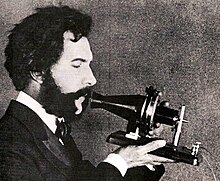Portal:Telephones

A telephone is a telecommunications device that permits two or more users to conduct a conversation when they are too far apart to be easily heard directly. A telephone converts sound, typically and most efficiently the human voice, into electronic signals that are transmitted via cables and other communication channels to another telephone which reproduces the sound to the receiving user. The term is derived from Greek: τῆλε (tēle, far) and φωνή (phōnē, voice), together meaning distant voice. A common short form of the term is phone, which came into use early in the telephone's history.
In 1876, Alexander Graham Bell was the first to be granted a United States patent for a device that produced clearly intelligible replication of the human voice at a second device. This instrument was further developed by many others, and became rapidly indispensable in business, government, and in households. (Full article...)

A mobile phone (or cellphone) is a portable telephone that can make and receive calls over a radio frequency link while the user is moving within a telephone service area, as opposed to a fixed-location phone (landline phone). The radio frequency link establishes a connection to the switching systems of a mobile phone operator, which provides access to the public switched telephone network (PSTN). Modern mobile telephone services use a cellular network architecture, and therefore mobile telephones are called cellphones (or "cell phones") in North America. In addition to telephony, digital mobile phones support a variety of other services, such as text messaging, multimedia messaging, email, Internet access (via LTE, 5G NR or Wi-Fi), short-range wireless communications (infrared, Bluetooth), satellite access (navigation, messaging connectivity), business applications, payments (via NFC), multimedia playback and streaming (radio, television), digital photography, and video games. Mobile phones offering only basic capabilities are known as feature phones (slang: "dumbphones"); mobile phones that offer greatly advanced computing capabilities are referred to as smartphones. (Full article...)
A smartphone (often simply called a phone) is a mobile device that combines the functionality of a traditional mobile phone with advanced computing capabilities. It typically has a touchscreen interface, allowing users to access a wide range of applications and services, such as web browsing, email, and social media, as well as multimedia playback and streaming. Smartphones have built-in cameras, GPS navigation, and support for various communication methods, including voice calls, text messaging, and internet-based messaging apps. (Full article...)
Selected article -

Types of phones -

A payphone (alternative spelling: pay phone or pay telephone) is typically a coin-operated public telephone, often located in a telephone booth or in high-traffic public areas. Prepayment is required by inserting coins or telephone tokens, swiping a credit or debit card, or using a telephone card.
The company that operates the payphone generally pays either rent or a revenue share to the owner of the property where the phone is installed.
Invented in the late 19th century, payphones became ubiquitous worldwide in the 20th, enough to contribute to the notion of universal access to basic communication services. The charge for a call may be a flat rate, or dependent on call duration. Following the explosive growth of mobile telephony, the use of payphones, and the number installed, has decreased greatly. (Full article...)Selected audio -
The TeleZapper is a device designed to reduce the number of telemarketing-related phone calls a household receives by imitating the tone signal normally played by a phone company to indicate a line has been disconnected. The Telezapper was created by Privacy Technologies, Inc, a wholly owned subsidiary of Royal Appliance Mfg. Co. (Full article...)
List articles

- Comparison of smartphones
- List of best-selling mobile phones
- List of countries by number of broadband Internet subscriptions
- List of countries by number of telephone lines in use
- List of countries by smartphone penetration
- List of country calling codes
- List of iPhone models
- List of mobile network operators
- List of mobile phone brands by country
- List of mobile phone generations
- List of telephone operating companies
Related portals
General images -
Selected biography
George H. Sweigert (1920–1999) is credited as the first inventor to patent the cordless telephone.
Born in Akron, Ohio, Sweigert served five years in the US Army as a radio operator in World War II in Guadalcanal, Bougainville, Fiji and New Georgia assigned to the 145th Headquarters Company under the 37th Infantry Division (United States). Following the war, Sweigert attended Bowling Green State University near Toledo, Ohio.
Sweigert credited his military experience for invention of the cordless telephone, citing experimentation with various antennas, signal frequencies, and types of radios. (Full article...)Selected images
Topics
Subcategories

More
 |
Here are some tasks awaiting attention:
|
Telephones in the news
No recent news
Associated Wikimedia
The following Wikimedia Foundation sister projects provide more on this subject:
-
Commons
Free media repository -
Wikibooks
Free textbooks and manuals -
Wikidata
Free knowledge base -
Wikinews
Free-content news -
Wikiquote
Collection of quotations -
Wikisource
Free-content library -
Wikiversity
Free learning tools -
Wiktionary
Dictionary and thesaurus














































































































